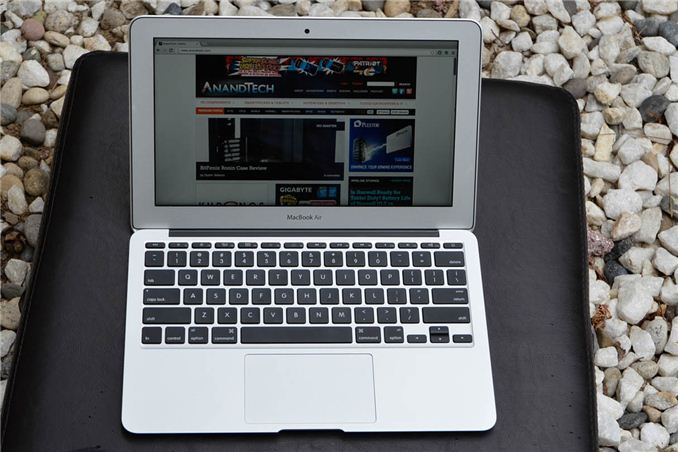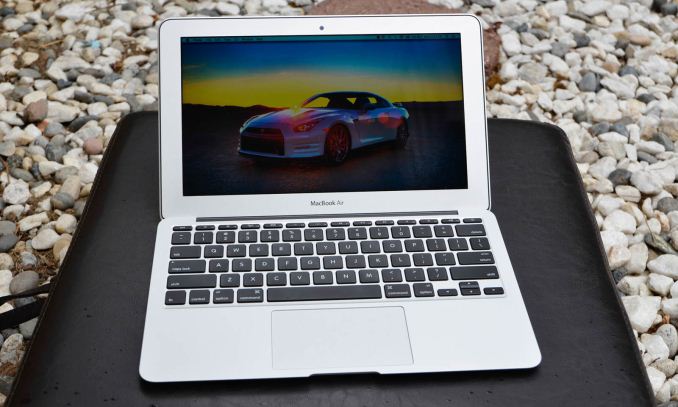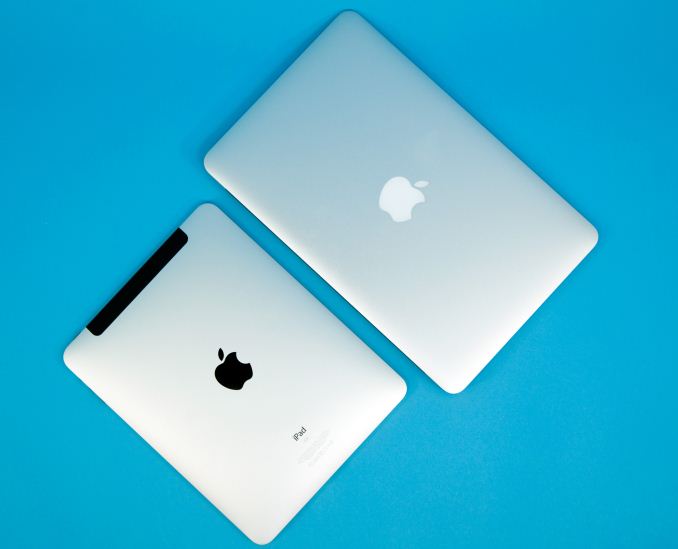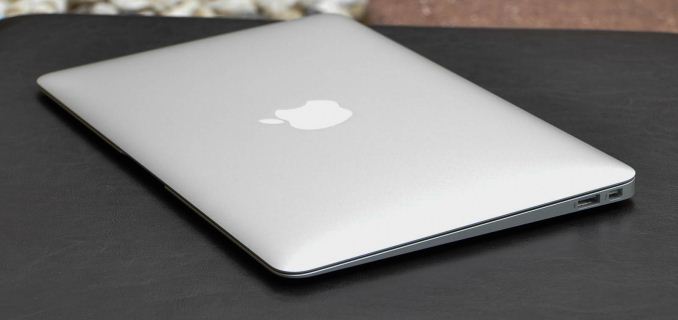The 2013 MacBook Air Review (11-inch)
by Vivek Gowri on August 9, 2013 1:45 AM EST
When Apple launched the second generation MacBook Air in late 2010, I was definitely more interested in the 11” model. It was nearly as small as the iPad, but as a full notebook it was considerably more useful. At 2.3lbs, it wasn’t even that much heavier and the $999 pricetag made it the least expensive mobile computer in Apple’s lineup. It wasn’t really perfect: the base SKU with a 1.4GHz Core 2 Duo ULV CPU and 2GB of memory seemed painfully inadequate at the time, the 5 hour battery life wasn’t great (the 13” Air was rated at a much better 7 hours), and $999, though cheap by Apple notebook standards, was a lot to justify spending on roughly year-old specs. Needless to say, I bought one. (Jarred’s thoughts at the time: “It has an Apple logo on it, so of course you bought one!”) And then I returned it. It was just unbearably slow
The base 2011 model having only 2GB RAM was basically laughable, and the standard 64GB SSD got a whole lot more indefensible as time went on, but the experience was significantly improved by the switch to modern microarchitectures in the newer 11” Airs. But even so, the 13”, with its higher screen resolution, 16:10 aspect ratio, and larger battery, seemed to be the way to go, especially after the price dropped to $1199.
For 2013, the entry level 11” and 13” SKUs have the same basic specs: 1.3GHz Haswell ULT processor, 4GB LPDDR3, and a 128GB SSD. The price difference has dropped to $100, with the 13” falling to $1099—making it feel like a way better deal, considering the extra battery life (12 hours versus 9 for the 11”) and larger, higher resolution display. And honestly, the 13” is not only a more usable primary computing solution, but also a better computer overall, so I’ll just get that part out of the way first. I will say though, it’s far easier to recommend an Air 11” now that the base model has the 4GB/128GB combo I’d consider the minimum for any ultraportable computer. It took a few years, but it finally became possible to recommend the base 11”er without any caveats. Where the 11” Air becomes really interesting though is when you stop thinking about it in terms of its larger sibling, but in terms of the iPad.
| 2013 MacBook Air Lineup | ||||||
| 11.6-inch | 11.6-inch (high-end) | 13.3-inch | 13.3-inch (high-end) | |||
| Dimensions |
H: 0.11-0.68" (0.3-1.7cm)
W: 11.8" (30cm) D: 7.56" (19.2cm) |
H: 0.11-0.68" (0.3-1.7cm)
W: 12.8" (32.5cm) D: 8.94" (22.7cm) |
||||
| Weight | 2.38 lbs (1.08kg) | 2.96 lbs (1.35kg) | ||||
| CPU | 1.3GHz dual-core Core i5-4250U | |||||
| GPU | Intel HD 5000 | |||||
| RAM | 4GB LPDDR3-1600 | |||||
| SSD | 128GB PCIe SSD | 256GB PCIe SSD | 128GB PCIe SSD | 256GB PCIe SSD | ||
| Display Resolution | 1366 x 768 | 1440 x 900 | ||||
| Ports | Thunderbolt, 2x USB 3.0, headphone jack | Thunderbolt, 2x USB 3.0, SD card slot, headphone jack | ||||
| Networking | 2x2:2 802.11ac | |||||
| Battery | 38 Wh | 54 Wh | ||||
| Price | $999 | $1199 | $1099 | $1299 | ||
Not only is the Air 11” dimensionally similar to the iPad, but now with Haswell it has roughly equal battery life too. And given that there’s just a $200 price difference between the 128GB iPad and the 128GB Air 11”—$100 if you factor in the cost of an iPad keyboard—it’s really something to think about. Sure, the iPad has a better display and is touch capable, but this is a real computer. It’s just as easy for me to carry the Air 11” as it is for me to carry the iPad, it even fits into the iPad pocket in my backpack.
The images Anand took for the first 2010 Air review keep coming back to me—the size difference really isn’t that much. The current iPad is thinner and lighter than the first gen that we had back then, but not by much, and the footprint hasn’t changed at all. Other than the extra 2.3” in width and few hundred grams in weight (it’s just under a pound heavier), the two are pretty similar. The depths are within a quarter inch of each other and the average thickness of the wedge-shaped Air is essentially the same as the constant thickness of the iPad. So this form factor with this battery life and these specs—does that make the 11” Air compelling enough to justify buying instead of the 13” or another PC notebook in this class?
Hardware
We’re really familiar with this generation of MacBook Air. This is now the fourth generation using this chassis (C2D, SNB, IVB, now Haswell) and in that time, not much has changed. The Air family added Thunderbolt and backlit keyboards in 2011 and moved to MagSafe 2, USB 3.0, and HD webcams last year, but other than that, this is externally essentially the same computer it was back in 2010. This year, the Air gets a second microphone hole in the left side. For reasons unknown, the listed weight for the Air 11” changed from 2.3lbs to 2.38lbs between 2010 and 2011, but has stayed constant at the latter in the generations since.
The chassis is still phenomenally thin and very well put together, with a pleasing simplicity and extremely compact dimensions all around. The keyboard and trackpad are still the best on the market, and it’s awesome to note the uniformity of Apple’s keyboard from the 11” Air through the rest of their larger notebooks and the wireless keyboard that ships with the iMac. I don’t understand how nobody else has figured out how to make a buttonless trackpad as good as Apple’s at any point over the last five years. Over the last few years, I’ve been tempted to buy a Mac more than a few times just because of how good the input devices are. It’s legitimately an advantage that Apple holds for their entire notebook lineup, one that is very critical in a smaller notebook like this one. There’s not much in the way of port selection, but that’s actually not too big of a deal. Perhaps after years of living with ultramobile systems, I’ve learned to make do with just two USB ports and a video out, but it’s honestly good enough for this class of notebook.
There’s a lot new on the inside though. In addition to Haswell ULT, Apple has pushed the envelope and gone for PCIe SSDs and 802.11ac. Considering the other innovations Apple has brought to the mobile computing space over the years, it’s probably not that surprising that they were the first to get ac and PCIe storage into Ultrabooks. Sony has since also started shipping a set of similar systems with PCIe SSDs in their VAIO Pro Ultrabook line, and I’d be very surprised if many of the other high-end Ultrabooks set to launch later in the year don’t have at least one of those two things.
Anand has covered the different Haswell ULT parts used in the Airs pretty in-depth so I’m not going to go into too much detail here. The base model Air 11” that we’re looking at today has the i5-4250U, a 1.3GHz part with max turbos of 2.6/2.3GHz (1C/2C) and Intel’s HD 5000 onboard graphics with a max GPU clock of 1GHz. The i7-4650U is a $150 option and bumps base clock to 1.7GHz, turbo to 3.3/2.9GHz (1C/2C), and GPU max to 1.1GHz. I typically don’t go in for Apple’s upgrade pricing, but this is actually pretty reasonable given the performance increases involved. I think I’d be more tempted to go for the upgraded CPU in a 13”, simply because I’d want to eke every drop of battery I could get from the smaller notebook. The battery has been upsized, now to 38Wh from the previous 35. It’s still a fair ways behind the 13” in terms of battery capacity though; the 54Wh battery in the larger unit represents a 42% increase in size that more than offsets the display-related power consumption delta.



















139 Comments
View All Comments
jutre - Thursday, August 15, 2013 - link
Sorry name99, but I do not really mind your opinion, given your clear lack of judgment in posting comments. If you re-read carefully my post and the one from purerice, you will not find any complaint.jutre - Thursday, August 15, 2013 - link
I have not worked with a SSD-based computer so far. I am used to keeping multiple applications opened at the same time, because launching them takes to much time, so I really need 8Gb or RAM on my 2009 Imac. With an SSD-based laptop, maybe usage patterns change and you no longer need as many apps opened at the same time, so need less RAM ?HodakaRacer - Saturday, August 10, 2013 - link
Battery life and Performance with windows bootcamped? I know Anand tweeted about running windows on it..cindaydavilla - Saturday, August 10, 2013 - link
my buddy's step-aunt makes $61 every hour on the computer. She has been without work for 6 months but last month her pay was $14651 just working on the computer for a few hours. Here's the site to read more... www.max38.comccd2 - Saturday, August 10, 2013 - link
I disagree with you comment on the iPad versus MBA 11". After using the iPad for 6 months, I understand why you believe tablets are going to settle in at 7-8". That size tablet is easy to hold in one hand and, even more importantly, light enough to hold with one hand for extended periods of time. So why would I want the MBA which is even more awkward to handle??? It's even heavier, the keyboard does not fold fully around like the Yoga or detach. The MBA isn't better than an iPad because it can't be used the way most of us use a tablet.And as a PC? Why get the MBA when a larger PC like the 13" MBA is simply a better device?
Convergence devices like the 11" MBA have to make a decent compromise between tablet and PC to justify their often premium prices. I just don't see any device which has made a compelling argument for these devices. Some are getting close, like the Surface Pro or XPS12, but there is still more development to be done
FwFred - Saturday, August 10, 2013 - link
You hold a laptop (it's in the name "lap") far differently than a tablet. A 13" laptop is not awkward in the least. A 13" tablet is laborious to use. The point of the 11" is you bring your computer with you. When you get home, you can even dock it to a keyboard/mouse/monitor and use full fledged desktop software.I agree a 13" laptop is a better experience... unless you are very mobile and you always have your laptop stuffed in your bag.
ccd2 - Saturday, August 10, 2013 - link
You kind of support my point. Used as a laptop, in your lap, an 11" PC doesn't offer any real advantage over a 13" laptop. Stuffed in my bag, the weight difference doesn't matter much either. A 11" laptop needs to be some sort of convergence device for most of us, otherwise there are better options like a bigger laptop.Impulses - Saturday, August 10, 2013 - link
I've kind of given up on convergence devices for now... I enjoyed my Transformer, but I've moved on to a smaller Nexus 7. I was excited about Surface Pro, but it's just too much of a compromise for the price... Same for the 11" MBA. Even $500 Silvermount convertibles that finally break past the Atom performance envelope are unlikely to tempt me.I guess there's a reason the traditional laptop form factor has endured... I think some of the more interesting convergence devices are actually those that stick to one role without sacrifices and only offer extra versatility as a second choice... The Yoga 13 hinge design is rather appealing, I doubt I'd prop it up like an easel or whatever often but it takes nothing away from it's role as a laptop.
ccd2 - Saturday, August 10, 2013 - link
I agree. I'm looking at the new Nexus 7 as well. The problem with convergence devices is that they charge a premium for being a convergence, but just don't work that well. For the price of most of them, I can have a good 7" tablet and a larger PC with no compromises.name99 - Saturday, August 10, 2013 - link
The value of a large iPad is as a document reader. Not an eBook reader, but a technical document reader --- generally, but not limited to PDFs. This market appears to be large enough (individuals who most read tech documents, like myself, business use cases, and older people with bad eyes for whom the extra screen space is worth the other hassles) to sustain the 10" iPad indefinitely. Heck, if we assume the rumors to be true, there is enough of a demand for document readers that it makes sense for Apple to try a 13" iPad form factor.The basic point is that people use these devices in different ways. There is no way I would ever consider a 7" iPad -- it is useless for my specific needs. But obviously other people love it.
It is a waste of time from the point of view of market analysis to rely on anecdote ("I use this device in this way, and likewise all my [demographically identical] friends".)
Unless one has specific numbers regarding how people use devices, we have to rely on the common sense observation that if a company keeps making and selling a product, there is a substantial group of people who want it. Apple has been selling the 11" MBA for a while now. This seems to suggest that, in spite of your theoretical analysis, there IS a large enough group of people for whom this size is best that it remains a viable product.
I am sympathetic to your analysis. I have made a very similar analysis claiming that one of the reasons Surface Pro is not a viable product is because it fits uncomfortably between the cell phone (which everyone has and which serves mobile tasks well) and the laptop (which everyone has if they hope to do any sort of real work with Windows).
But at the end of the day, we have to calibrate these arguments to reality, especially if they're arguments from the gut without numbers to support them. I'd say reality supports my argument (Surface Pro is not and will not be viable) whereas it does not support your argument.
(It would be an interesting twist on your argument to consider why Apple can sell this form factor successfully whereas Windows cannot. Perhaps it is the very fit and finish of Apple --- a quality keyboard and trackpad --- along with OSX and its support for full-screen apps with maximum use of the display and easily controlled multiple virtual displays --- which makes the difference. A lousy keyboard and trackpad may be more painful in smaller form factor, and Windows full screen mode may still include enough chrome that each window is just that much less useful? In theory Windows8 Metro solves the chrome problem, but Metro has its own issues in that it does a terrible job of information density. Space isn't wasted in chrome, instead it's wasted everywhere.)